karnal
Well-known member
Today when installing my new Canyon Cages, I decided to give the bags a once-over. Yup, one screw missing; the other 3 without locktite were there and fairly tight. However, missing one screw allows the plate to twist under the remaining screw and theoretically loosen it over time.
Replaced the missing screw with a phillips (the threads were slightly jacked, probably from a violent exit of the screw - phillips helped me better locate the screw into the threads) and locktite on all, using pliers to remove and reinstall the remaining 3 torx security bits (can't find my set.)
Replaced the missing screw with a phillips (the threads were slightly jacked, probably from a violent exit of the screw - phillips helped me better locate the screw into the threads) and locktite on all, using pliers to remove and reinstall the remaining 3 torx security bits (can't find my set.)
































































